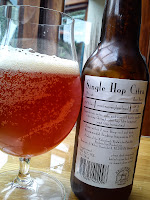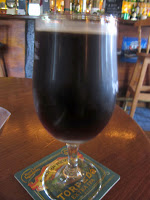The October Bank Holiday Weekend means only one thing to me, and that's the Franciscan Well October Beer Fest. You can keep your 'jazz'.
After being bustled by the throngs at last year's festival, I made a point to get in early this time around. How else can a man take notes? I was quiet enough around 4 o'clock when I got in, and as with my previous festival experiences, I was a bit spoilt for choice. Painfully ignoring the St. Bernardus Christmas Ale is something that will live with me for months. Still though, I was on a hop hunt, so much of the dark strong Belgians were out of my sight.
I opted instead to start in the U.S, and my first Anderson Valley beer, their Hop Ottin' IPA of 7% ABV. Turns out this is a solid choice, with loads of tropical fruit, grapefruit and orange pith and sugary malts on the nose. It's zesty bitterness is pinned down by a creamy body that speaks plenty of it's candy, caramel biscuit malt backbone. Nicely balanced but delivering a nice slap of fresh-tasting hop notes, I'll be coming back to Anderson Valley in the bottle.
I couldn't avoid Belgium forever, so Gouden Carolus Hopsinjoor was a must, ticking the hop box at least in theory. In practice, it's not far off; lemon sherbert and a herbal, almost medicinal leafiness makes a fine aroma, while the taste allows more of the overripe banana and bubblegum sweetness through. The star of the show, however, is the mildly spicy coriander, complimating the lighter citrus flavours of the beer. Full-bodied and buttery, it might not be for everyone, but I enjoyed my half.
Flying Dog's Wildeman wasn't going to be one for a while, I was told, and Thornbridge's Wild Raven was getting it's line cleaned upstairs, so in the meantime I took a break from the hops to try out the Franciscan Well's own Dunkel Weisse. Despite completing the banana, citrus, bubblegum and clove checklist expected of a good Dunkel, it's falls a bit flat on it's light body and carbonation, feeling a bit thin at times. A pint of this with a sausage in a bun would have been a treat, but a half pint after two thick and ballsy beers left me wanting.
And so with Thornbridge Wild Raven back on, it was to the upstairs bar I went. The aroma is odd, with charcoal, black pepper and a hint of lime zest, with the taste bringing things to a whole new level of weird. Burnt rubber and seaweed were surprising, but definitely present, while a herbal, spicy, citrus fruit hoppiness and and a woody, sweet biscuit malt backbone tied things to reality. A strange experience, no doubt with thanks to the line-cleaning. I think I'll have to try this in the bottle.
On that sort-of bum not, I realised the place was getting incredibly busy, and decided to call it a day. A poor choice, as it turned out, because a keg of Black's Black IPA was tapped before I even made it to the bus stop. Oh well...
Great line-up and organisation from the Franciscan Well yet again, though I have to say I'm looking forward to the early spring festival even more.
















